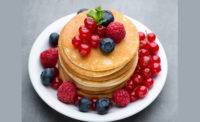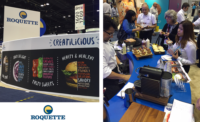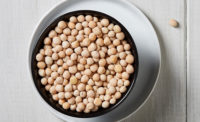Roquette Americas: Win-Win Formulations
There are novel ways reduce sugars and add functionality to confections and snacks

Recognized as a global epidemic by the World Health Organization (WHO), obesity is a public health concern. It can lead to increased risk factors associated with cardiovascular disease, stroke, diabetes, and some types of cancer.
The Center for Disease Control (CDC) reports that in the US, more than one third of American adults are obese. In an effort to acknowledge the leading causes that underlie the obesity epidemic, consumers demand a better balance between nutritional value and taste.
Establishing such a balance is important in traditionally indulgent sectors, such as confectionery. Although sugar and sugar-free confectionery have their place within healthy eating patterns (that is, in moderation), sugar reduction and claims of such are of interest.
This movement towards sugar reduction—not only in confectionery applications but in cereals, snacks, culinary, and other segments—is in-line with the WHO recommendations. Furthermore, the 2015-2020 Dietary Guidelines for Americans (DGA) recommend following a healthy eating pattern in which added sugars are limited, and comprise no more than 10% of total daily calories. For this reason, sugars are a topic of particular current interest.
Traditional Confectionery Application
The confectionery industry offers an array of candy and other confections based on the use of sugars. However, the word “sugar” does not refer to a sole ingredient, as there are a variety of sugars available. Each sugar has different properties that lead to the ability to control sweetness, calories, and functionality in confections.
Some examples of different uses of sugars are that of traditional “sugar” confectionery (sucrose-based confectionery) and sugar-free confectionery, targeting the significant market interested in calorie control and/ or glycemic impact control, such as is required by persons with diabetes. To understand the differences between sugars and their applications in formulation, it is important to expand on their definition and their properties, including the unique chemaical structure of each type of sugar.
In a labeling sense, sugars are defined as the total amount of monosaccharides and disaccharides present in a formulation. Dextrose (also called glucose) and fructose are monosaccharides, but sucrose (commonly referred as “table sugar”) is a disaccharide formed by the bond between the monosaccharides glucose and fructose. Such mono- and disaccharide sweeteners include honey, invert-sugar, high-fructose corn syrups and some glucose syrups (depending on their dextrose equivalency). All are classified as sugars or mostly sugars.
Sucrose-based confectionery is reliant on a combination of sucrose and pure glucose syrup, in which the ratio between these two ingredients impacts the overall texture of the final product. For example, a balance higher in sucrose would lead to a crystalized product (e.g. fudge), while the opposite would lead to a non-crystallized application (e.g. gummy).
This functionality (also known as “graining” and “non-graining”) is observed in other types of carbohydrate sweeteners naturally occurring in many fruits and vegetables. These are sugar alcohols, also known as polyols. Commercially, they’re derived from sugars by hydrogenation of monosaccharide or disaccharide sugars. For example, sorbitol and xylitol (common sweetener ingredients used in chewing gum) are derived from dextrose and xylose, respectively.
Sugar alcohols are commercially available in crystal and syrup form, and as with sucrose-based confectionery, the ratios between the crystalline form and the syrup form allow processors to control the overall texture (graining) of the finished confection. Polyol-based confectionery is used mostly for candy formulations serving the diabetic demographic.
Maltitol is a polyol also commonly used in confectionery applications intended to reduce calories (besides reducing the glycemic impact of sucrose). An example is the use of maltitol in sugar-free confectionery coatings used in traditional confectionery and snacks to reduce overall sugar levels. Most polyols are about 66-90% or more the sweetness level of sucrose.
Besides reducing sugar content in confectionery applications, sugar alcohols are lower in calories by about one-third to one-half the calories of sucrose, making them important as bulk sweeteners. As with sugars, sugar alcohols can be monomers (e.g. xylitol, sorbitol, mannitol, and erythritol) or dimers (e.g. maltitol, isomalt, and lactitol). The physical properties (sweetness, solubility, heat of dissolution) of sugar alcohols differ from each other and also influence sensorial properties in the finished product.
Xylitol is the sweetest of the commercial polyols and compares directly to the sweetness of sucrose. Of disaccharide sugar alcohols, maltitol has 90% the sweetness of sucrose as well as comparable solubility. It can readily be used as a direct substitute for sucrose in many applications. However, most sugar alcohols have a negative heat of dissolution, causing a “cooling” effect in the finished product. This is one of the reasons why some sugar alcohols are particularly desirable in chewing gum and mints intended to refresh the palate.
Examples of applications of sugar alcohols in confectionery range from chewing gum and mints to fondant, chewy candy, hard candy, caramel, peanut brittle, confectionery coatings (chocolate, yogurt, etc.), and hard coatings (as in coated gum, chews or nuts products).
Confectionery Meets Snacks
Many confectionery applications are “blurring the lines,” merging into the snacks market. While traditional confectionery will always remain an important indulgent item in a balanced diet, confectionery intended for snacking, or snacks mixed with confectionery concepts, opened the door to innovative ways to meet customer demands.
Both the confectionery and snack market segments experienced similar positioning claims among their top ten claims for the products launched in the last six months, according to Silvia Schnicker, America’s marketing manager for Food Ingredients at Roquette Americas, Inc., and based on new (2015) data provided by Mintel Market Reports.
For both categories, Confectionery and Snacks, “Low,” “No,” and “Reduced” as well as “Allergen-Free” and “Gluten-Free” are important claims among recent product launches. “GMO-free” is among the top 10 claims of recent launches for snacks. Regarding the top 10 flavors most prevalent in recent launches for these merging categories, peanut butter, chocolate, and fruit were strongly present. This is exemplified by the incorporation of fruit, peanut butter, or chocolate into agglomerate bars or snacks coated with confectionery coatings (e.g. chocolate, yogurt, lemon coatings).
Confectionery coatings find wide uses in snacks, and can therefore be used to formulate for reduced sugars in the overall snack, and/ or introduce functional properties to it. Confectionery coatings are most common in their chocolate (milk or dark) and yogurt form, and these can be used in traditional confectionery items or in snacks.
Unlike true chocolate, with its strict standard of identity, chocolate coatings may make use of fats of higher melting points than that of cocoa butter, and also may have bulking sweeteners other than sucrose. A full substitution of sucrose by maltitol leads to sugar-free coatings of reduced calories, and can be successfully produced in milk- and dark-chocolate versions, as well as flavored coatings.
Protein and Fiber in Reduced Calorie Coatings
An alternative to sugar and sugar-free coatings based on sugar alcohols is that of “reduced sugar” and “no sugar added” coatings. These can achieve such a claim by using bulk ingredients with added nutritional value and functionality. An example of added functionality and sugar reduction is that of reduced-sugar vegan confectionery coatings with pea protein. Unlike soy and milk proteins, pea protein sourced from yellow peas is not a major allergen. Pea protein can be used for partial replacement of sugar and cocoa, to achieve a sugar-reduction claim as well as a protein claim.
For coating applications, Roquette scientists have successfully incorporated up to 25-30% protein in a commercial basis, leading to an excellent source of protein in a 40g serving size of coating, creating a non-dairy, vegan dark chocolate coating with reduced sugar. Such reduced-sugar, protein-enriched coatings can then be used for the formulation of healthful snacks, such as breakfast bars with protein or protein-enriched products for sports nutrition. The protein in the coating, allows formulators of protein-enriched products to have more leeway in product development.
Another way to achieve sugar reduction, and even “no sugar added” claims in coatings, is through the use of fibers. Not all fibers are created equal, and for sugar reduction it is important to consider fibers that have minimal monosaccharides and disaccharides in their composition. This is especially important when formulating for a “non-sugar added” claim. Fibers can be used in partial or full replacement of sucrose to achieve “reduced-sugar” or “no-sugar added” claims. The resulting coatings have the additional value of being a good or excellent source of fiber, depending on the amount of fiber used.
Sugar reduction and protein or fiber enrichment in confectionery coatings does not always translate to calorie reduction: Coatings have a high amount of fat in their formulation, and this is needed to achieve specific physical properties required for processing. The high fat content makes it difficult to considerably reduce the caloric content without modifying the overall properties of the finished product. However, if reducing calories is of importance, sugar-free options are an ideal solution since sugar alcohols eliminate roughly half of the calories arising from sugar.
As some confectionery applications merge with snack applications, new sweetener opportunities allow processors to bring functionality while introducing sugar-reduction in formulations. Confectionery coatings, commonly used in snack applications, can be formulated to be of reduced-sugar and high-protein content, or reduced-sugar and high-fiber content, for example. Reducing sugar in the coating and bringing functionality to it, gives more leeway in the formulation and development of snacks, and is therefore an appealing solution to formulate snacks with lower sugar content.
Leslie Kleiner is a project coordinator, Confectionery Applications for Roquette Americas Inc.
For more information:
Roquette America, Inc.
Customer Innovation Center
2211 Innovation Drive
Geneva, IL 60134
(630) 463-9430
www.roquetteamerica.com
info@roquetteamerica.com
Looking for a reprint of this article?
From high-res PDFs to custom plaques, order your copy today!





